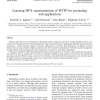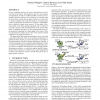252 search results - page 45 / 51 » How Secure is Deterministic Encryption |
CN
2007
13 years 7 months ago
2007
Intrusion detection is a key technology for self-healing systems designed to prevent or manage damage caused by security threats. Protecting web server-based applications using in...
WS
2005
ACM
14 years 1 months ago
2005
ACM
Mobile ad hoc networks (MANETs) offer communication over a shared wireless channel without any pre-existing infrastructure. Forming peer-to-peer security associations in MANETs i...
DATE
2010
IEEE
14 years 21 days ago
2010
IEEE
For any computing system to be secure, both hardware and software have to be trusted. If the hardware layer in a secure system is compromised, not only it would be possible to ext...
ASIACRYPT
2003
Springer
13 years 11 months ago
2003
Springer
This paper introduces the concept of certificateless public key cryptography (CL-PKC). In contrast to traditional public key cryptographic systems, CL-PKC does not require the use...
ICPADS
2008
IEEE
14 years 2 months ago
2008
IEEE
The use of good random numbers is essential to the integrity of many mission-critical systems. However, when such systems are replicated for Byzantine fault tolerance, a serious i...


